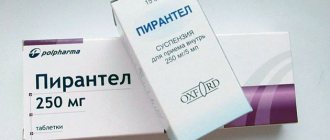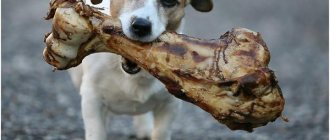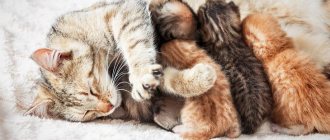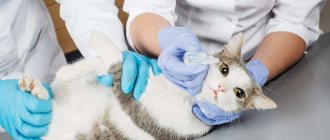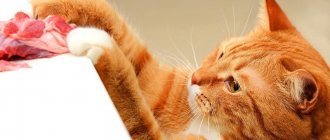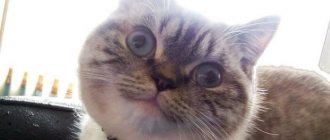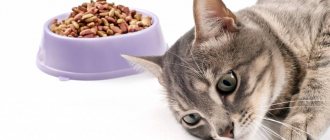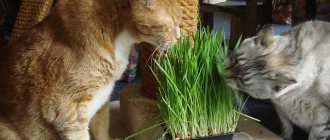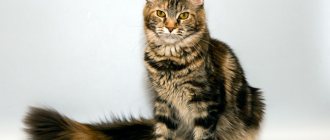Smecta is rightfully considered one of the most effective drugs that helps a person cope with diarrhea. However, for the felines he became an equally loyal friend. The main thing is to learn how to correctly calculate the dosage. Moreover, you can understand how to give Smecta to a cat by carefully reading just one article. Intestinal upset is not a rare disease for your beloved pet. There is always a reason for diarrhea. It could be something unsuitable for food, obtained on the street, or a stolen piece from the table. In any case, Smecta will be the salvation.
Composition and action
The active substance of Smecta is diosmectite. This is a natural component, a mixed oxide of silicon and aluminum (or magnesium and aluminum silicate). Sodium saccharinate and dextrose promote better absorption of the medicine. The powder may have a citrus or vanilla flavor, but for animals it is better to choose a medicine without flavoring.
The general effect of diosmectite in both humans and animals is the adsorption of pathogenic microorganisms located in the gastrointestinal tract. It has the ability to bind toxins and infection-causing pathogenic microflora in the animal’s body. The mucous barrier is stabilized, the amount of mucus increases and its gastroprotective properties improve.
An important therapeutic effect of the drug is to protect the mucous membranes of the digestive tract from the negative effects of hydrochloric acid, bile, bacteria and their toxins, and various other aggressive factors. An additional protective layer of the mucous membranes of the gastrointestinal tract eliminates irritation and prevents further intoxication of the body.
Important!
The drug is absolutely safe for animals, however, it reduces the rate of absorption of other medications, so it is not recommended to give Smecta to a cat simultaneously with other medications.
The procedure for introducing the drug into the cat's mouth
To help a cat cope with the disease, the breeder will need 1 sachet of Smecta, boiled and cooled water in advance, a clean towel and a syringe without a needle. Despite the malaise, not every animal completes the course of treatment prescribed by the veterinarian or the breeder himself with great pleasure. To give Smecta to a cat, the owner will have to show miracles of ingenuity and simple admonitions; kind words will not help here. It is much easier to adhere to certain rules .
- Place the contents of the sachet into the prepared container. For an adult cat, 1.5 grams of Smecta is enough. The powder should be diluted to a pasty consistency. This will require 50-100 ml of water.
- To inject the prepared suspension into the cat's mouth, a regular 2-cc syringe is suitable. It must be filled in advance so as not to irritate the sick animal.
- Immediately before administering Smecta, you should wrap your beloved pet in a thick cloth or towel. In this case, it is necessary to fix his legs and body, but do not overdo it. Do not forget that the unfortunate mug is most likely suffering at the moment from severe pain in the tummy.
- The syringe is inserted into the cat's mouth from the side where the teeth are missing. You don't have to make any special efforts. There is no point in carefully opening the mouths of Murka or Barsik. It is enough to lift the upper lip by 1-2 mm and gradually squeeze out the contents of the syringe.
© shutterstock
How many times a day to give a cat Smecta depends solely on the condition of the animal. For the most severe disorders, veterinarians recommend repeating the procedure for administering the drug every hour. Particular attention should be paid when treating kittens. If after 6-8 hours the furry little one’s condition does not improve, you should immediately seek help from a qualified veterinary clinic specialist. In such cases, there is always a risk of having diseases not only of the gastrointestinal tract.
Purpose
Smecta is used as veterinary first aid for the first symptoms of gastrointestinal diseases, accompanied by vomiting and diarrhea. The drug is used as an enterosorbent for digestive disorders associated with poisoning from poor-quality food or a change in feed. The drug is safe for pets, including kittens.
The indication for prescribing Smecta as a medicine is diarrhea of various etiologies:
- with individual intolerance to certain foods;
- an excess of proteins in the diet (diarrhea is often accompanied by itchy skin and hair loss);
- transferring an animal from natural food to industrial feed and vice versa;
- transferring kittens after weaning from a cat to adult food;
- long-term treatment with antibiotics;
- infectious diseases.
Smecta will help against vomiting that accompanies infectious diseases or is caused by overeating (often in kittens that do not feel full), or the accumulation of hairballs in the gastrointestinal tract.
Important!
When vomiting, the composition of the vomit should be taken into account. If there is blood in them, you should immediately show your pet to a veterinarian, since this symptom indicates internal bleeding.
Causes of diarrhea in cats
Almost every owner has had to deal with intestinal upset in pets. Even a seemingly insignificant event such as moving to a new apartment can cause stress in cats, causing diarrhea. In small kittens, intestinal upset can be caused by overeating. After transferring a kitten to “adult” food, its body needs to readjust: to digest wet and dry food, different enzymes are needed than to digest mother’s milk. In addition, kittens do not feel full - they will eat until there is no food in the bowl.
Much more serious problems are caused by dangerous pathologies:
- poisoning;
- viral infections;
- imbalance of intestinal microflora - including after antibiotic therapy;
- helminthic infestations.
The biggest danger with prolonged diarrhea is the risk of dehydration. A large amount of fluid is washed out of the body with feces. A life-threatening condition occurs if the body loses 15-20% of water. Dehydration can cause the kidneys to fail, and then the pet will die. Therefore, it is important to consult a veterinarian for intestinal disorders and not self-medicate.
Important!
Prolonged diarrhea (more than 3 days) leads to weight loss, dehydration, loss of protein, and impaired tissue trophism. The result may be chronic renal failure, hypothermia, convulsions, and cerebral hypoxia.
Diarrhea may be accompanied by vomiting, and these are not always signs of poisoning. More often this is a systemic disorder, the causes of which can be different - from intestinal obstruction to oncology.
If you have diarrhea, you should pay attention to the color of the stool: it can indicate in which organ the pathology is developing:
- Unformed yellow stool may indicate diseases of the liver parenchyma. You should contact your veterinarian immediately;
- Green diarrhea can be observed due to putrefactive processes in the intestines, poisoning with low-quality feed, stale food;
- White feces are the most dangerous symptom of bile duct blockage and require immediate contact with a veterinarian.
Mucus in the stool is a sign of intestinal inflammation, an imbalance of beneficial and harmful bacteria in the gastrointestinal tract. It can be a sign of a deadly disease - viral peritonitis, and therefore requires complex treatment, and Smecta is used as a means of symptomatic therapy - to improve the condition of the animal.
Important!
Other dangerous viral diseases accompanied by diarrhea include enteritis and panleukopenia (feline distemper).
Diarrhea with blood is a reason to immediately contact a veterinary clinic. It may be a symptom:
- poisoning with pesticides, household chemicals;
- rectal trauma, intestinal rupture;
- acute pancreatitis;
- helminthic infestations (infection with coccidia, Giardia);
- viral diseases, in particular coronavirus, panleukopenia;
- oncology.
What does the owner need to know when treating a cat with Smecta?
The result of the treatment will not take long to arrive: literally in 2-3 hours the pet will feel much better. During the procedure for administering the drug to an animal, the owner needs to make sure that the kitten has swallowed the drug. If an attempt to administer the prepared emulsion is unsuccessful, you should start treatment again. It is possible that outside help may be needed to achieve the goal.
If there is no improvement, the procedure must be performed again after 3-4 hours. It is equally important to provide the cat with sufficient fluid intake to avoid dehydration. At the same time, you can wait until the functioning of the digestive organs is completely restored. In the absence of positive dynamics in the treatment of the animal, it is advisable not to neglect the advice of specialists. By contacting a veterinarian, who will give additional recommendations for treatment or prescribe another medicine, the owner will help rid his pet of diarrhea much faster.
Dosage
You can buy Smecta at any pharmacy. 1 sachet contains 3 g of powder for preparing a suspension. The dosage will depend on the age and weight of the pet. Kittens can be given enterosorbent from 1 month. To prepare the suspension, you need to take 0.5 sachet and 50 ml of water (for adult cats) or ¼ of the contents of a sachet and the same amount of water (for kittens). The solution must be mixed thoroughly until the powder is completely dissolved, then drawn into a syringe. It is more convenient to use small, 2-5 cc syringes.
You need to infuse the medicine after securing your pet with a towel or diaper. This way you can protect yourself from the cat’s sharp claws. For kittens, the volume of the finished medicine for one dose is 2 ml, for adults – 5 ml. You need to pour the solution into the mouth carefully, from the side, then lightly pinch the muzzle and mouth so that the cat cannot spit out the medicine. After 1-3 hours, the procedure should be repeated.
Important!
Taking Smecta does not relieve the owner of the need to take the cat to the veterinarian to determine the cause of the intestinal disorder.
How to properly treat a cat
The dosage of Smecta for diarrhea and other intestinal diseases is prescribed to a cat or dog directly by a veterinarian. However, many experienced breeders often self-medicate. In this case, the dosage of the drug will have to be calculated independently. Smecta is a medicine developed for people. It is packaged in small bags of 3 grams and is a white powder. Recommendations in the instructions for use of Smecta apply exclusively to humans.
Until the breeder contacts a veterinary clinic specialist for advice and receives special recommendations, as an emergency measure, you can take half a bag of Smecta and dissolve the powder in ¼ cup using slightly cooled boiled water. Some pets like the taste of the drug and do not cause any problems when taking it . In this case, you can simply pour the resulting solution into a small bowl and make sure that the cat laps up a sufficient amount of the suspension. You will have to tinker a little with capricious pets.
Restrictions
The drug has no contraindications. Smecta can be used to treat kittens from one month of age, pregnant and lactating cats. However, if the cat has a tendency to constipation, it is not recommended to give the suspension even with loose stools. The prohibition for taking is intestinal obstruction.
Important!
If, after taking Smecta, the cat has difficulty defecating (constipation), the medicine should be discontinued or, after consultation with a veterinarian, the dosage should be changed.
What it is
Smecta is a preparation based on the natural substance diosmectite - white clay.
It is a mixture of aluminum and magnesium. The supplier of unique raw materials for the medicine is a volcanic deposit from the Mediterranean island of Sardinia. Belongs to the group of effective sorbents. The mechanism of action is simple. The product enters the stomach, absorbs harmful microelements that cause the disorder.
Clears toxins and leaves the body undigested. Sold as a powder weighing 3 g.
Benefits of the medicine:
- It is not absorbed into the blood and does not accumulate in the body.
- It is located only in the gastrointestinal tract.
- Has a preventive effect.
- Has no side effects.
Reception by children
Smecta can be given to children from infancy. Often, babies have problems with the digestive system in the first days of life.
The instructions say that you can give the medicine from 4 weeks. The remedy can be given for malnutrition, which leads to abdominal pain and bloating, vomiting and diarrhea. Also effective for jaundice.
The optimal dose is determined only by a doctor. You need to dilute the powder in warm milk or water (50 ml), stirring until you get a homogeneous consistency. The specified volume must be divided into several doses.
For diarrhea
If a baby has diarrhea at the age of 1-12 months, then in the first 72 hours you need to give 2 sachets, after which you can give 1 sachet per day. Children from 1 year old can be given 4 sachets in the first 3 days, and after that - 2 sachets per day.
When vomiting
For vomiting in children under 1 year of age, give 1 sachet per day. A child over one year old can be given 3 sachets per day. If constipation occurs, the dose should be reduced.
Price and analogues
The cost of Smecta depends on the number of sachets in a cardboard box, pharmacy and region. The price for 10 sachets of the drug varies on average from 141 to 170 rubles.
It has many analogues, including:
- Activated carbon is a popular sorbent that is not used to treat diarrhea in kittens. The price for 10 tablets varies from 5 to 10 rubles.
- Neosmectin is a domestic analogue of Smecta. Both drugs belong to the same price category.
- Enterosgel is an effective drug for diarrhea, the effect of which occurs much faster. The price for 225 g varies from 430 to 570 rubles.
- Polysorb - enterosorbent is used for diarrhea due to poisoning, poor nutrition or the introduction of new products. Prescribed for long-term treatment. The cost ranges from 230 to 350 rubles. for 25 years
Treatment of cats and kittens for diarrhea at home
First of all, don't panic. You should especially not start worrying if the animal is vaccinated and has not come into contact with dubious feline personalities. We remember that the main thing is to assess the condition and find out the causes of diarrhea in the cat.
You should be aware that home treatment with proper nutrition may not be effective in serious cases. Such severe ailments require medical intervention. However, there are a number of medications that are effective in treating the symptoms of bowel disorders, some of which are used in human treatment.
Medicines and dosage for diarrhea in cats
Despite the extensive list of drugs that can help a meowing sufferer with an intestinal disorder, not all of them are recommended by specialists. Any medicine is not a panacea, and in difficult cases, eliminating symptoms is simply dangerous for the cat’s life.
Here is an approximate list of effective remedies for diarrhea in cats:
Enterofuril is an effective broad-spectrum antimicrobial drug. The medication does not disturb the intestinal flora, so the rapid effect of enterofuril does not carry with it any side effects for the intestines. The medicine is excellent in treating feline diarrhea if the cause is bacterial infections, but viral stool disorders can also be treated. The price for enterofuril varies from 270 to 350 rubles; The dosage of the suspension for adult cats is 100 milligrams. For kittens 5 times less; Give 2-3 times a day, 12 or 8 hours apart; If over the last 10-12 hours the signs of diarrhea disappear, then the drug is stopped;
Diarcan is a medicine that is dissolved in water and offered to the pet to drink or added to the food. If the situation does not improve within 5 days, the drug is discontinued, since the diarrhea is not due to infection. The dosage is strictly observed, half a cube for cats up to 5 kg and a cube over. There is an 8-hour break between doses. The drug costs about 500 rubles; Furazolidone is an antimicrobial drug that is effective due to the fact that bacteria develop resistance to it poorly. Treatment of loose stools with this remedy should be prescribed by a doctor who will select the correct dosage regimen. Typically, the daily dose is divided into three parts, each third mixed with food. Furazolidone can be bought for an average of 100 rubles; Bifidumbacterin is a probiotic that normalizes the functioning of the gastrointestinal tract. The product is sold in the form of tablets, powder and suppositories. Bifidumbacterin is indicated for long-term viral diseases of the cat and during a course of treatment with antibiotics. The cost of the probiotic depends on the dosage, but for cats the price will be approximately 100-200 rubles; Smecta and activated carbon are enterosorbents that remove toxins from the gastrointestinal tract. If the bowel disorder does not last long, then the cat can be given smecta to drink. The price for smecta enterosorbent is 130-150 rubles; Enterosgel - the drug actively cleanses the cat’s body of toxins, helps with poisoning, intestinal infections and after antiparasitic treatment
It would be better if a specialist prescribes such a remedy for your pet, because it is important not only to relieve the symptoms of the disease, but also to find the cause. Phthalazole is an antimicrobial medicine. Even salmonella is repelled from this medication
The remedy has been proven for weakening the intestines by more than one generation of mustaches. The tablet must be crushed, mixed with water and offered to the animal in a syringe. There are contraindications for use. The price of tablets is 30-40 rubles; Loperamide - a tablet is a savior, but not a cure. The symptoms of diarrhea will disappear, but the cause will remain. Loperamide is excellent at removing bacteria and parasites from the body, but it is worth consulting with a qualified specialist. Loperamide costs 15-30 rubles; Levomycetin is a strong drug that neither gram-positive nor gram-negative microorganisms can resist. Side effects will not appear if you follow the instructions and dosage. Otherwise, skin rashes, flatulence, and dermatitis may appear. The drug is contraindicated for pregnant cats or animals with kidney and liver diseases.
Now it’s clear what can be given to a cat for diarrhea, but you shouldn’t blindly hope for miraculous remedies, since the cause is sometimes difficult to establish. The cause of the disease is the main thing worth fighting. The veterinarian will not only help you find the cause of the bowel disorder, but will also prescribe a competent course of treatment.
Mechanism of action of the drug
"Smecta" has an absorbent effect on the body. The active substance collects toxins and harmful microorganisms found in the intestines and is excreted unchanged along with feces or urine. In addition, the components of the drug come into contact with glycoproteins of mucous tissues and form polyvalent bonds, creating a natural barrier to hydrochloric acid, bile salts and waste products of harmful bacteria.
Special conditions and contraindications
Since Smecta has an enveloping effect and absorbing abilities, it can influence the speed and degree of adsorption of other drugs. The highest thickness of mucus is formed within 30 minutes after taking the drug, then it gradually decreases. Therefore, it is advisable to give any other medications to the animal at least 1 hour before taking Smecta. Otherwise, the product will bind to the sorbent and leave the body without having time to act.
You should not give Smecta to a cat if you suspect intestinal obstruction.
Natural causes of diarrhea in kittens
A newborn kitten has a sterile microflora, that is, its intestines are not populated by bacteria. When the baby begins to suck mother's milk, the intestines are populated with lactobacilli, which will help the baby digest milk, and then adult food. In the first days after birth, cat milk is very rich in lactobacilli; it is commonly called colostrum. After 2–3 days, the milk becomes more protein-rich, acquires a white color and a fatty consistency.
Usually the kitten’s digestive system copes with the first stage of adaptation without problems. Difficulties may arise if the cat does not feed the kittens and they had to be switched to milk replacers. No matter how hard biologists and scientists try, it is still impossible to recreate the structure of colostrum. It turns out that even using a special cat's milk substitute, you deal a blow to the baby's sterile digestive system. Further, everything will depend on the potential strength of the body. Statistically, only seven out of ten artificial kittens survive.
The next step in a kitten's development is the transition to adult food. Typically, kittens begin to be fed with boiled minced meat or special food at the age of 3.5–5 weeks.
It is important to understand that complementary foods should be introduced gradually, literally little by little, so that the intestinal microflora has time to react and adapt to unusual food
When food other than milk enters the kitten's intestines, the natural reaction of the mucous membranes will be irritation. A large amount of mucus will help soften and digest hard foods. It is absolutely natural that a kitten devouring minced meat will develop mild diarrhea, which will stop in less than a day and should not be repeated more than once. If everything went well, the next time you eat adult food, the microflora in the intestines will already be slightly changed.
If diarrhea starts and does not stop, you need to take action. Considering the small weight of the kitten, water loss during stool liquefaction becomes catastrophic. While an adult cat can cope with severe diarrhea for 1–2 days, a kitten becomes dehydrated within 8–10 hours.
Is it worth giving smecta to a kitten?
Smecta is a remedy that helps normalize digestion and eliminate diarrhea that occurs due to a change in diet or overeating. If the pet's stool has returned to normal and the pet is feeling good, then we can assume that in this case the use of the medicine was a sufficient measure. If stomach upset continues, you should contact your veterinarian to find out the cause.
In case of severe diarrhea, it is worth giving smecta as quickly as possible to prevent dehydration and absorption of toxins. After this, take the animal to a veterinary clinic.
It should be borne in mind that other medications can be given no earlier than 2 hours after taking the sorbent, otherwise they will have no effect.
General information
Diarrhea (popularly called diarrhea) is a digestive disorder that requires mandatory treatment. With each bowel movement, the pet's body loses a large amount of fluid, weakens and becomes depleted. If not treated promptly, diarrhea can lead to the death of the animal.
Diarrhea is often accompanied by nausea, abdominal pain, and vomiting. The animal experiences discomfort, anxiety, stress. He loses his appetite.
Diarrhea in a cat: how to properly treat an upset stomach
Diarrhea may also be accompanied by:
- fever;
- flatulence;
- fatigue, lethargy;
- nausea;
- vomiting;
- bloody discharge.
Diarrhea is not an independent pathology, it is only a symptom of existing health problems in your pet.
